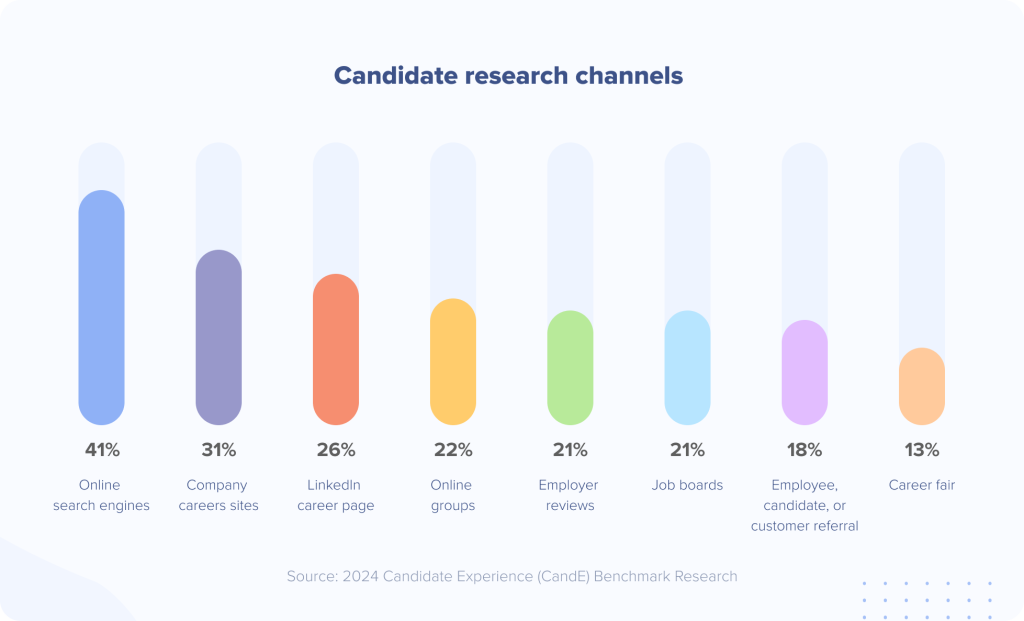
Subscribe for updates
Get talent acquisition best practices, trends, and news delivered directly to your inbox.
By entering your email, you agree to receive marketing emails from JobScore
Talented professionals evaluate opportunities based on many different factors. Some candidates prioritize finding an organization that aligns with their personal values, while others will prioritize opportunities with a solid compensation package. Some prefer work-life balance, while others prefer challenging work — even if it means putting in extra hours.
Employer branding can help you communicate what your organization offers candidates, allowing them to self-select whether your opportunity is a good fit. Strategically promote and amplify your employer brand across multiple channels to ensure that candidates find the information they need to make decisions.

Build an enticing careers site
Nearly a third of candidates (31%) say career sites are one of the most valuable channels for researching employers. This presents a tremendous opportunity to promote your employer brand and improve hiring outcomes. A well-designed careers site can significantly increase application rates and attract higher-quality candidates.
Here are some key elements that can help your organization stand out:
Pro tip:
Include a talent network on your careers site to capture candidates who are interested in joining your team, but don’t see the right opportunity.
Turn your team members into brand ambassadors
Current team members serve as your most credible employer brand ambassadors. When they share positive experiences about working at your company, their networks pay attention because the endorsement comes from a trusted source. Employee advocacy programs can significantly expand your reach without requiring a large investment.
Here are proven ways to activate and enable your team members as brand advocates:
Master your social media presence
Social media platforms offer powerful opportunities to showcase your company culture and connect with potential candidates. In fact, 26% of candidates use LinkedIn career pages to research jobs, while 22% use Facebook and LinkedIn groups.
Here are some ways you can use social media to promote your employer brand and engage job seekers:
Remember that social media employer branding is about building relationships and sharing information, not just posting job openings. The goal is to stay top-of-mind and stand out when talented professionals are ready to make their next career move.
Monitor employer reviews
Employer review sites like Glassdoor, Indeed, and Comparably can significantly influence candidate perceptions. One in five candidates (21%) cite employer review sites as a top channel for researching employers. Further, review sites often show up in online search engines, which 41% of candidates are using to research employers.
Many job seekers read company reviews before applying, and negative reviews can deter qualified candidates from considering your opportunities.
Here are some ways you can leverage employer reviews to attract the right candidates:
Use interviews to sell candidates on your opportunity
Interviews aren’t just an opportunity for you to evaluate candidates — they’re an opportunity for your candidates to evaluate you. Take time during the interview process to sell candidates on your role, team, and organization, further promoting your employer brand.
Turn every interview into a compelling recruitment pitch with these strategies:
Leverage awards and media coverage
Recognition from third parties adds credibility to your employer brand and provides valuable content for your recruiting efforts. The 41% of candidates who use online search engines as their primary employer research channel may come upon awards, media coverage, and industry recognition in their search. These serve as external validation that can influence candidate decisions.
Build third-party credibility that attracts top talent:
Final thoughts on promoting and amplifying your employer brand
Your employer brand represents an investment in your company’s future growth and success. By systematically promoting your organization across multiple channels, you can attract higher-quality candidates while reducing recruiting costs and time.
Start with the areas where you can make the biggest impact quickly, then build on your success to create a comprehensive employer brand strategy that supports your long-term hiring goals.
An applicant tracking system like JobScore can help you promote your employer brand through an engaging careers site, consistent postings on job boards, and powerful communication tools. It can also help you track key metrics to measure and optimize your hiring outcomes. Start your free trial to see for yourself!



